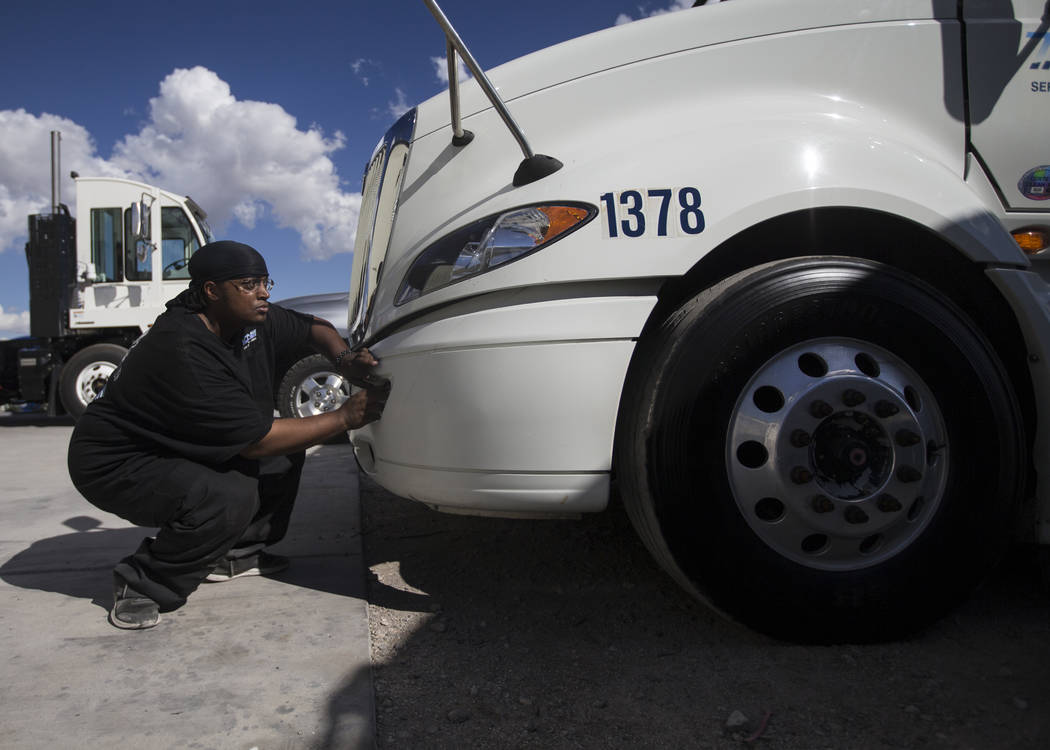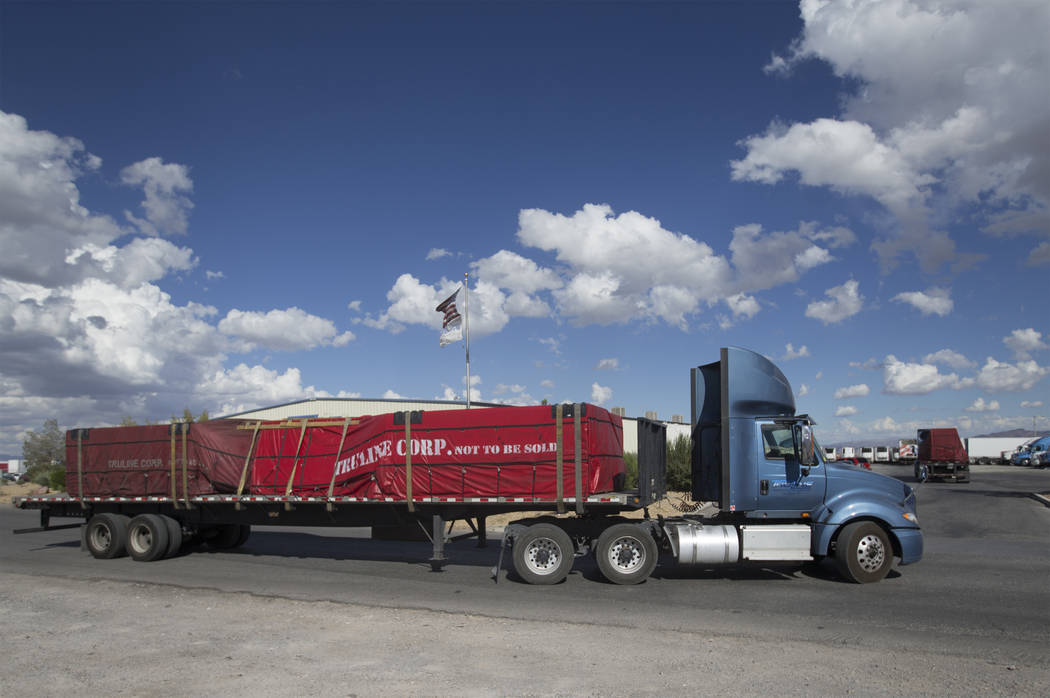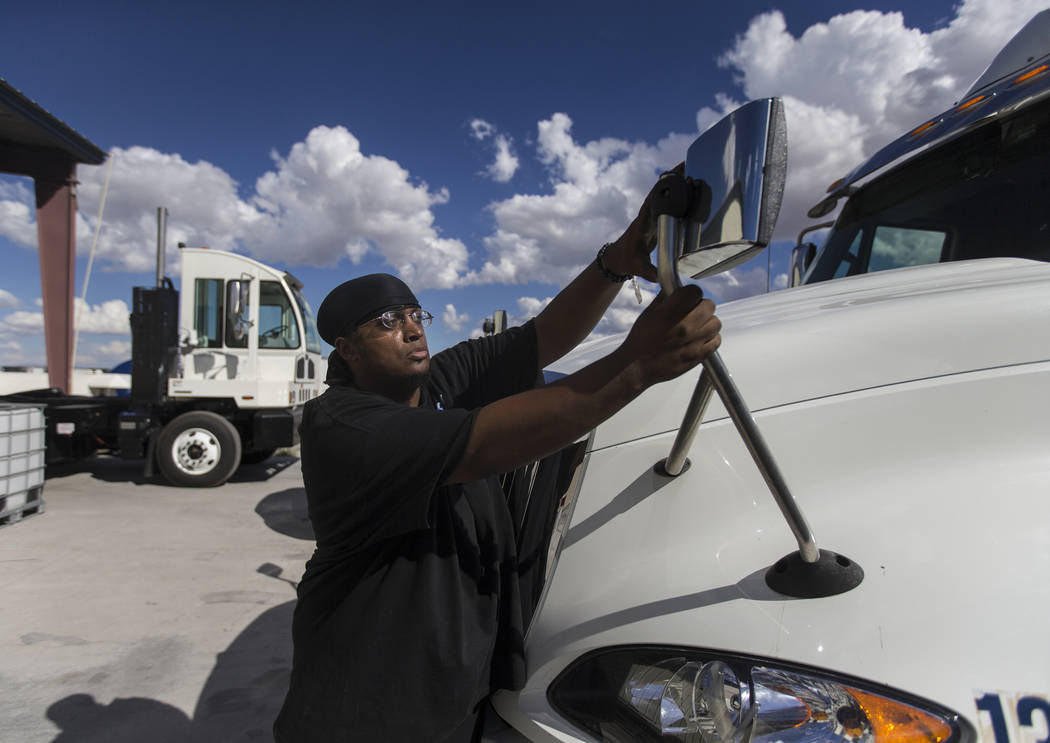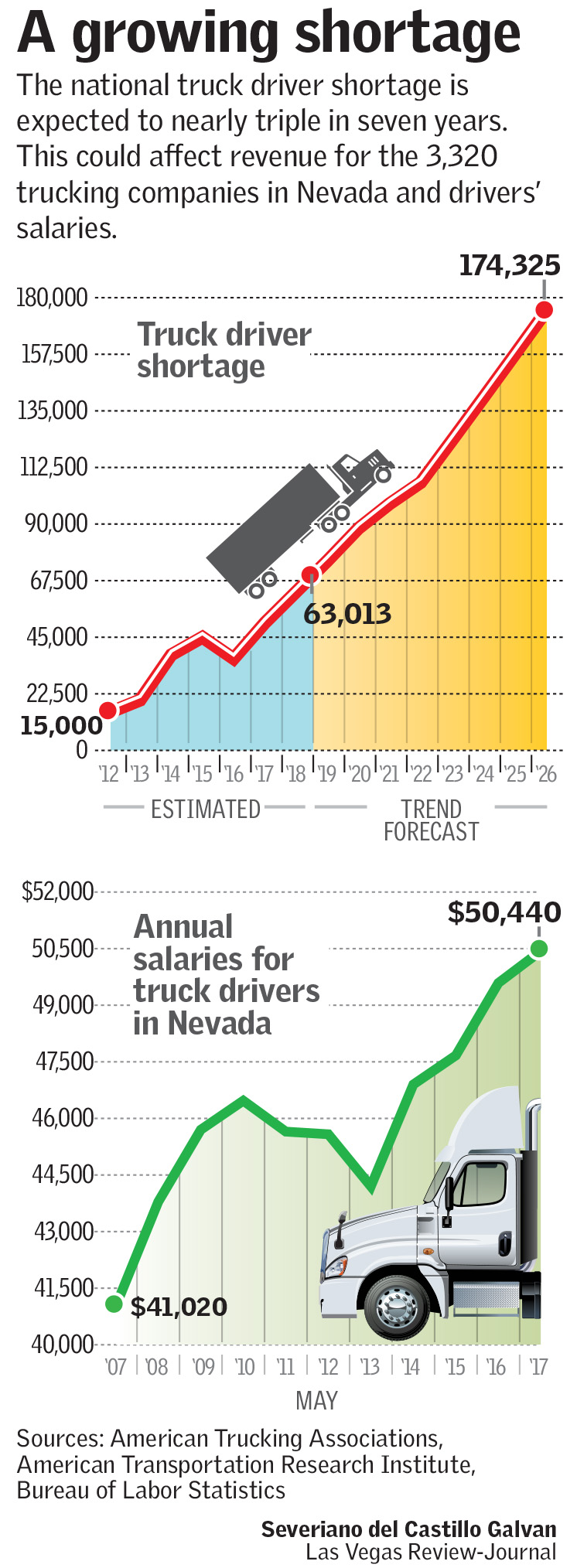Truck driver shortage eating into Las Vegas Valley company profits







At the Truline trucking company’s facility in the south valley, 18 trucks sit empty on a dirt lot — unused.
There’s nothing wrong with the semis, but they are missing one key component: drivers. Truline can’t fill jobs fast enough, and it’s costing the company millions.
Each of those trucks has the potential to earn about $200,000 annually, adding up to a total of about $3.6 million in unearned revenue, Truline President Paul Truman said.
Filling the shortage is “a high priority,” Truman said. “It’s a problem every (trucking) company has.”
The American Trucking Associations, a trade group based in Virginia, expects the national truck driver shortage to grow to at least 174,000 by 2026, more than four times the 36,500 shortage in 2016. That could have a major impact on companies in Las Vegas, a city that relies heavily on trucks for imported goods.
‘Reliant on trucking’
About 92 percent of manufactured goods in Nevada are transported in trucks, according to the Nevada Trucking Association. And Las Vegas imports more than twice as much as it exports, according to September data from FreightWaves.
“We don’t have a Mississippi River, we don’t have a huge amount of rail that’s moving freight … we don’t have seaports,” said Paul Enos, CEO of the Nevada Trucking Association.“The state of Nevada as a whole is more reliant on trucking.”
With fewer drivers available to transport a growing number of shipments, transportation costs have been rising. Kim Daniels, executive director of customs brokerage house Mercantile Logistics and International Trade Inc., said she has seen a 50 percent increase in shipping costs over the last 10 years.
“That is in direct relation to a lack of drivers,” she said.
Recruitment challenges
Damon Vernado, a 48-year-old driver with Truline, has been driving trucks for four years and enjoys the time spent on the road.
“There’s a lot of solitude,” he said. “I’m a guy who likes being alone.”
He believes younger generations have grown too lazy for the job, but that’s alright with him. “There’s more work for us,” he said.
Daniels said a lack of interest from younger job-seekers and a growing retirement rate, are the root of the shortage.
“There just aren’t that many people who want to do it,” she said.
She doesn’t blame them. Truck driving can be physically taxing. There’s a lack of mobility, especially for long-haul drivers, and it’s easy to fall back on a diet that consists of fast-food burgers and gas station snacks.
According to the Center for Disease Control and Prevention, truck drivers have higher rates of heart disease, diabetes, hypertension and obesity compared with other adult workers in the United States.
“You’re talking about a population of people that are trying to do their jobs like everybody else, but their jobs are just asking so much of their bodies,” Daniels said. “They don’t have treadmills at these truck stops.”
Competitive market
Paul DeLong, president of North Las Vegas-based Paul DeLong Heavy Haul trucking company, began to search for a new driver in early October after one of drivers retired. The ATA found the average driver age for truck drivers is 49, meaning a big number of trucking companies have employees who are approaching retirement. 
“I think the driver shortage (will get) worse, and I’m not sure what we’ll do about it,” DeLong said.
Trucking companies face roadblocks in recruitment efforts. Federal law prohibits those under 21 from driving a truck across state lines, deterring recent high school graduates from entering the field.
Truman said he has had to boost incentives to draw in more workers. He gave his employees a 5 to 7 percent pay increase this year and offers a sign-on bonus of up to $3,000. The average annual salary of a truck driver in Nevada as of May 2017 was $50,440, slightly higher than the national average of $42,480, according to the Bureau of Labor Statistics.
Even then, drivers tend to jump from one company to another, enticed by sign-on bonuses and other offers in the competitive market. A recent report from the ATA found turnover rates at large truckload fleets were up 4 percent in the second quarter to 98 percent, the highest level since 2015.
“It’s very competitive to hire and keep the best drivers,” especially in Las Vegas, where more short-haul drivers are needed as construction picks up in the valley, Truman said.
Eric Kaplan, owner of Las Vegas-based Premium Trucking, also pointed to the economy as a reason behind the shortage. The national unemployment rate reached 3.7 percent in September, the lowest since 1969, according to the Bureau of Labor Statistics.
“There’s more work,” Kaplan said. “More companies are successful. … There’s more and more demand.”
Autonomy’s solution
There are ways to ease the shortage, Enos said, but none would be an instantaneous fix.
Federal lawmakers are looking at allowing 18-year-old truck drivers to cross state lines, which would open up truck driving to recent high school graduates. Enos said the ATA is pushing for more trucking apprenticeships and more military hires.
Another piece of the solution could be autonomous driving.
The technology would come in steps as technology advances, according to Sam Abuelsamid, a senior analyst at Navigant Research.
He expects the first will be a hybrid trucking model that operates partially autonomously on highways, with a driver in each truck.
The next stage would use driverless platooning: a method that has truck drivers traversing the country with a driverless vehicle or two following close behind. The limited space between the trucks reduces drag and allows the vehicles to use less fuel. The final step will have trucks navigate the entire route without a driver.
Abuelsamid expects to see driverless platooning in the United States as early as 2023, depending on rules. Only 16 states, including Nevada, allow truck platooning.
‘Less nomadic lifestyle’
Abuelsamid said autonomous semis won’t be replacing truck drivers anytime soon. While driverless trucks will be able to travel on interstates, humans will need to navigate vehicles through city streets and complete the shipment’s final stretch to the loading dock.
Daniels said such a shift would create a “less nomadic lifestyle.” This system would keep drivers close to home instead of hauling cargo from state to state,.
“There will probably still be some long-haul drivers, but not as many will be needed in the future, alleviating the shortage and creating different types of jobs at the same time,” she said.
Enos said he sees this autonomous technology revolution as the next chapter for truck drivers as opposed to the final page.
“Truck driving jobs are not going to go away,” he said. “With greater adoption of this tech, this can improve the health of the driver and make their job less stressful. … (It) enhances the ability of our industry to attract new drivers.”
Contact Bailey Schulz at bschulz@reviewjournal.com or 702-383-0233. Follow @bailey_schulz on Twitter.













